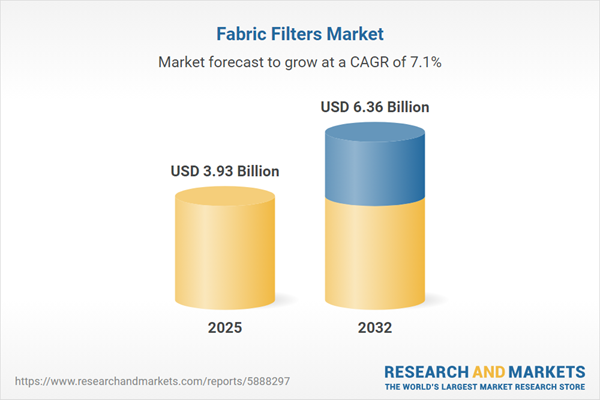Speak directly to the analyst to clarify any post sales queries you may have.
The fabric filters market is evolving rapidly as regulatory pressures and operational complexities increase across diverse industries. Senior executives are reevaluating air filtration strategies to ensure organizational resilience, optimize compliance processes, and maintain efficiency in a landscape marked by shifting standards and global diversity.
Market Snapshot: Growth and Dynamics in the Fabric Filters Market
The fabric filters market is projected to grow from USD 3.68 billion in 2024 to USD 3.93 billion in 2025, reaching a total value of USD 6.36 billion by 2032. Market expansion is closely linked to sectors such as heavy manufacturing, power generation, and waste management as organizations upgrade air quality management to satisfy stricter environmental regulations. Advancements in digital controls and improved filter media are reducing unplanned maintenance and streamlining operational scheduling. Due to regional variations in regulatory environments, companies are adapting procurement strategies to address localized requirements and sustain competitive standing.
Scope & Segmentation: Comprehensive Overview of Fabric Filter Solutions
- Application Areas: Fabric filters serve cement, chemical, food and beverage, petrochemical, pharmaceutical, steel production, power generation (including biomass, coal, gas-fired facilities), and waste management industries. Each application area comes with distinct compliance challenges and operational demands that influence filtration system selection.
- Filter Types: The market includes bag, cartridge, panel, and pleated filters, supporting a wide spectrum of operational scales and maintenance protocols. Type selection influences efficiency and ease of particulate removal.
- Filter Materials: Options such as acrylic, glass fiber, polyester, and polypropylene are tailored for durability and compatibility with specific environments. Material choice impacts operational reliability and guides resource planning efforts.
- Technologies: Facilities employ pulse jet, reverse air, and shaker system technologies. These systems are adaptable, supporting both continuous and batch-operated processes and offering flexibility in response to varying throughput requirements.
- Filtration Mechanisms: Both depth and surface filtration mechanisms are available, with choices affecting particulate capture performance and shaping maintenance strategies, particularly where dust loads are significant.
- Regional Coverage: The market is active across the Americas, Europe, Africa, Middle East, and Asia-Pacific. Unique regulatory frameworks in each region necessitate a customized approach to sourcing and compliance management for effective system implementation.
- Key Companies: Leading organizations—Donaldson Company, Parker-Hannifin, Camfil AB, MANN+HUMMEL, Nederman Holding, Ahlstrom Oyj, FLSmidth & Co., Munters Group, Metso Outotec, and Porvair plc—set industry standards, drive technological innovation, and define best practices for performance.
Key Takeaways: Strategic Insights for Senior Decision-Makers
- Modernizing filtration systems bolsters compliance and operational resilience as regulations and standards change across regions.
- Transitioning to advanced fiber blends and hybrid materials can extend filter life, helping organizations optimize maintenance intervals and reduce total operating costs.
- Integrating IoT and analytics empowers facilities to anticipate service needs and minimize unplanned disruptions, supporting smoother plant operations.
- Sustainable sourcing through reclaimed or biodegradable filter media aligns purchasing with corporate sustainability goals and evolving environmental expectations.
- Customized filtration and process improvements for regulatory-intensive sectors, such as pharmaceuticals and steel, can simplify compliance management and secure production reliability.
- Stronger supplier evaluation protocols, especially for automated operations with complex supply networks, support proactive risk identification and stable procurement outcomes.
Tariff Impact: US Policy and Supply Chain Considerations
Recent increases in US tariffs affecting filter system components have resulted in elevated procurement costs. Many companies are adjusting supplier networks and considering local production to maintain supply stability. A well-coordinated approach to procurement and logistics is increasingly important for adapting to regulatory changes and minimizing supply chain disruptions.
Methodology & Data Sources
This market research draws from direct interviews with industry executives and insights from sector experts. All findings are cross-referenced with technical documentation, patent filings, and regulatory disclosures to deliver rigorously validated, practical intelligence for the fabric filters market.
Why This Report Matters
- Helps executives refine procurement and R&D practices to stay ahead of changing compliance demands.
- Provides actionable guidance for selecting filtration systems and evaluating suppliers, supporting alignment with strategic business priorities.
- Equips leaders to foresee operational shifts, enabling timely decisions on technology adoption and supply chain management.
Conclusion
This report delivers actionable insights to support investment in filtration technologies, enable effective supplier collaboration, and help organizations address new risks arising from regulatory and market evolution.
Additional Product Information:
- Purchase of this report includes 1 year online access with quarterly updates.
- This report can be updated on request. Please contact our Customer Experience team using the Ask a Question widget on our website.
Table of Contents
3. Executive Summary
4. Market Overview
7. Cumulative Impact of Artificial Intelligence 2025
Companies Mentioned
The companies profiled in this Fabric Filters market report include:- Donaldson Company, Inc.
- Parker-Hannifin Corporation
- Camfil AB
- MANN+HUMMEL GmbH
- Nederman Holding AB
- Ahlstrom Oyj
- FLSmidth & Co. A/S
- Munters Group AB
- Metso Outotec Oyj
- Porvair PLC
Table Information
| Report Attribute | Details |
|---|---|
| No. of Pages | 183 |
| Published | November 2025 |
| Forecast Period | 2025 - 2032 |
| Estimated Market Value ( USD | $ 3.93 Billion |
| Forecasted Market Value ( USD | $ 6.36 Billion |
| Compound Annual Growth Rate | 7.0% |
| Regions Covered | Global |
| No. of Companies Mentioned | 11 |









